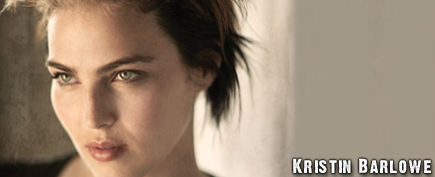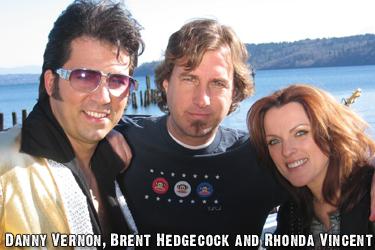Make That a Double - Directors Who Shoot Videos and Still Photography Tie Themes Together
By Mark Crawford



May 17, 2005
© Mark Tucker
Marketing a Country song through a three-minute music video is an art form in itself. It is no easy task to seamlessly meld the artistry of performer, photographer and video director together to create a final product that feels intimate and familiar to the listener. All of this is usually accomplished in a few jam-packed days of shooting, when schedules and budgets are tight.
To streamline costs of film crews, hair and makeup, stylists/wardrobe specialists and the artists for a video, some record companies hire video directors who can also shoot still photography for the CD cover, packaging and publicity use.
Lyric Street Records is one of the record labels in Nashville to embrace this concept. "We've been doing this ever since we opened our doors," said Greg McCarn, Vice President of Marketing, Lyric Street Records.
Elvis impersonator Danny Vernon; Brent Hedgecock and Rounder recording artist Rhonda Vincent on the set of her video "I've Forgotten You" in Vashon Island, Wash. Photo courtesy of Brent Hedgecock.
The logistical benefits are obvious - doing both at the same time saves money. Everybody that's needed for a photo shoot is already there on the video set. By not having a separate photo session, record labels save money on wages, travel, hotel expenses and more.
But that's not the main reason for McCarn. "Even though there are some cost savings, the big thing is that it allows us to create a continuity between the video and the photographs on the CD packaging," he said. "I like to connect the dots for the consumer. Because the CD shots are usually from the same sets used in the video, it's easier for consumers to make that connection, to remember the appeal of the video when they look at the CD on the rack."
"99.9 Percent Sure"
About two years ago, McCarn approached director/producer/photographer Brent Hedgecock, who was more famous for his video work (Josh Gracin, Andy Griggs, Warren Brothers) than his still photography. McCarn asked him to do both for Brian McComas' self-titled CD released in 2003, featuring the hit "99.9% Sure (I've Never Been Here Before)."
"We probably drove 500 miles scouting out sets for Brian's video," Hedgecock said, who is represented by Picture Vision Pictures. "I kept the treatment loose. The basic idea was to show the artist's journey, traveling from location to location. Trying to get back to somewhere. The images of oil fields were included to show Brian's connection to Oklahoma."
While driving between set-ups, the crew chanced upon a small roadside diner near Bakersfield, Calif. where they stopped to buy egg sandwiches. Hedgecock had his cameras ready and shot some photographs, one of which became the cover for McComas' CD.
"It was a very spontaneous thing," Hedgecock said. "There was no plan in the video for a diner scene. But it turned out these were some of the strongest images, so one made it to the cover. And I like it because it creates a continuity between the album and the video."
Finding the Right Photographer
Teresa Simon, former Creative Director with RPM Management and DreamWorks Records Nashville, has been hiring still photographers to shoot videos for years.
"Still photographers have an incredible ability to capture an entire mood in a split second," Simon said. "They look at things a little differently than video directors do. I hired Jon Ragel, a well-known lifestyle photographer in New York City, to shoot photos of Jessica Andrews - he absolutely nailed an emotion. He pulled things out of her that translated so well into the "Who I Am" video. Kristin Barlowe is also one of my favorites - she did some breathtaking work with Joanna Janet."
With SHeDAISY's Sweet Right Here Lyric Street Records CD, McCarn went to Barlowe, a nationally accomplished still photographer. "SHeDAISY was my first combination shoot," Barlowe said, who is represented by Taillight TV. "We did the 'Passenger Seat' video in the first two days, saving the last day for the photo shoot."
Barlowe's treatment for the video included a circus theme, which appears in the background of the CD photographs. "I was entrusted with a lot," she said. "I had to do justice to three exceptionally beautiful, talented girls. And they were so game. You know, it looks warm and sunny on the video, but it was actually freezing cold and the winds were blowing the sets apart."
A surprising number of artists don't like to do still photographs. "For me, a combination shoot is ideal," Barlowe continued. "After two days of shooting video, the artists are more relaxed. They have more confidence in your skills and a certain amount of trust has been built up with the crew and makeup people. And for a great photo shoot, I need the artist to trust me, because taking a picture is a very intimate process."
Developing a Bond
David McClister, a photographer/director with Picture Vision Pictures, recently finished a combined shoot with Buddy Jewell in support of his new Columbia Records album, Times Like These, released on April 26. "I did the photo shoot first in this cool old bar in Memphis, a two-story speakeasy," McClister said. "We picked stills that were perfect for Buddy, that had a bit of an edge to them. Then the video for "If She Were Any Other Woman" was designed to have the same look, the same kind of setting, colors and lighting."
A music video takes a couple of 10-12 hour days, where everything is planned beforehand, often down to the minute. For McClister, the best part of shooting both the video and the photographs is that it's an opportunity to get to know the artist better.
"With videos, directors don't get to hang out much with the artists," McClister said. "But I do get to spend quality time with them during the photo shoots. I also get to see what their strengths and weaknesses are, and how they respond to the camera. After a photo shoot I know the best angles, and what they can and can't do in a video, which is a huge advantage in developing the treatment and making them feel comfortable with what they're doing."
© 2005 CMA Close Up News Service / Country Music Association, Inc.